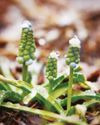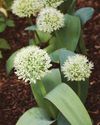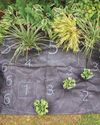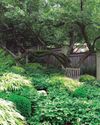
But before you panic and kill an unusual or new-to-you insect you have found, make sure it is correctly identified and not a native harmless or beneficial bug lookalike. "Confirm Before You Crush" at right will help you avoid a case of mistaken identity.
SPOTTED LANTERNFLY Lycorma delicatula
Found in 14 Eastern and Midwestern states, spotted lanternfly has more than 70 host species, including tree of heaven (Ailanthus altissima), maples (Acer spp. and hybrids), oaks (Quercus spp. and hybrids), many fruit and nut trees, and grapes.
HOW TO IDENTIFY IT Egg masses look like a smear of mud and are found on tree bark, as well as outdoor furniture or vehicles. Nymphs are black or red with white spots and are mobile from spring to fall. Adults appear in summer and are 1 inch long with gray or brown front wings with black spots and red hind wings with black spots and black and white bands at the edge.
DAMAGE Sap-feeding nymphs excrete sticky honeydew, often causing black sooty mold to grow on foliage. Plants are stressed by the feeding and may not die right away, but will be cosmetically affected, and fruit and nut crops will have lower yields.
WHAT TO DO Inform your state’s Department of Agriculture if you find spotted lanternfly so they can track its spread. Take a picture and note its location, then destroy the insect. Scrape off egg masses and seal in a plastic bag to destroy. These insects can hitchhike as adults or egg masses to new locations on vehicles and transported items like firewood, so some affected states have enacted quarantines on items likely to host egg masses.
この記事は Garden Gate の Issue 172 - August 2023 版に掲載されています。
7 日間の Magzter GOLD 無料トライアルを開始して、何千もの厳選されたプレミアム ストーリー、9,000 以上の雑誌や新聞にアクセスしてください。
すでに購読者です ? サインイン
この記事は Garden Gate の Issue 172 - August 2023 版に掲載されています。
7 日間の Magzter GOLD 無料トライアルを開始して、何千もの厳選されたプレミアム ストーリー、9,000 以上の雑誌や新聞にアクセスしてください。
すでに購読者です? サインイン

Backyard Tornado
\"HE WHO SEARCHES FOR SPRING WITH HIS KNEES IN THE MUD FINDS IT, IN ABUNDANCE.\" - ALDO LEOPOLD

Front-of-the-Border "Wow!" Power
When it comes to easy-care plants that bring a lot of punch to the border, 'Ivory Queen' Turkestan onion should be near the top of your shopping list.

GARDEN ESSENTIALS
MAKE GARDENING EASIER THIS YEAR

Elevate an Evergreen Hedge
Although an evergreen hedge looks suitable all year on its own, it's perfectly poised to become something even greater: a backdrop to a garden where flower after flower will unfurl with such drama, you just might find yourself stepping outside and offering your applause.

One Garden, Two Worlds
In this colorful and welcoming garden, sunny, flower-filled front borders transition to a shady backyard hideaway.

on edge
Four garden pros share their go-to edging techniques.

DIANTHUS
Add fragrance, vivid color and timeless charm with this reliable, cold-hardy perennial.

2025's Best New Plants!
Are you ready to start planning for next year's garden? A few new plants might be just what you need to bring those dreams to reality.

Solve Garden Problems With Ground Covers
Are you tired of coaxing turfgrass to grow in difficult spots? In her book Groundcover Revolution, Kathy Jentz says that ground covers can be the solution to these struggles.

The Romance of Spring
With the arrival of spring, emerging perennials fill the garden with soft texture, restoring life to the harsh, often barren landscape of winter.